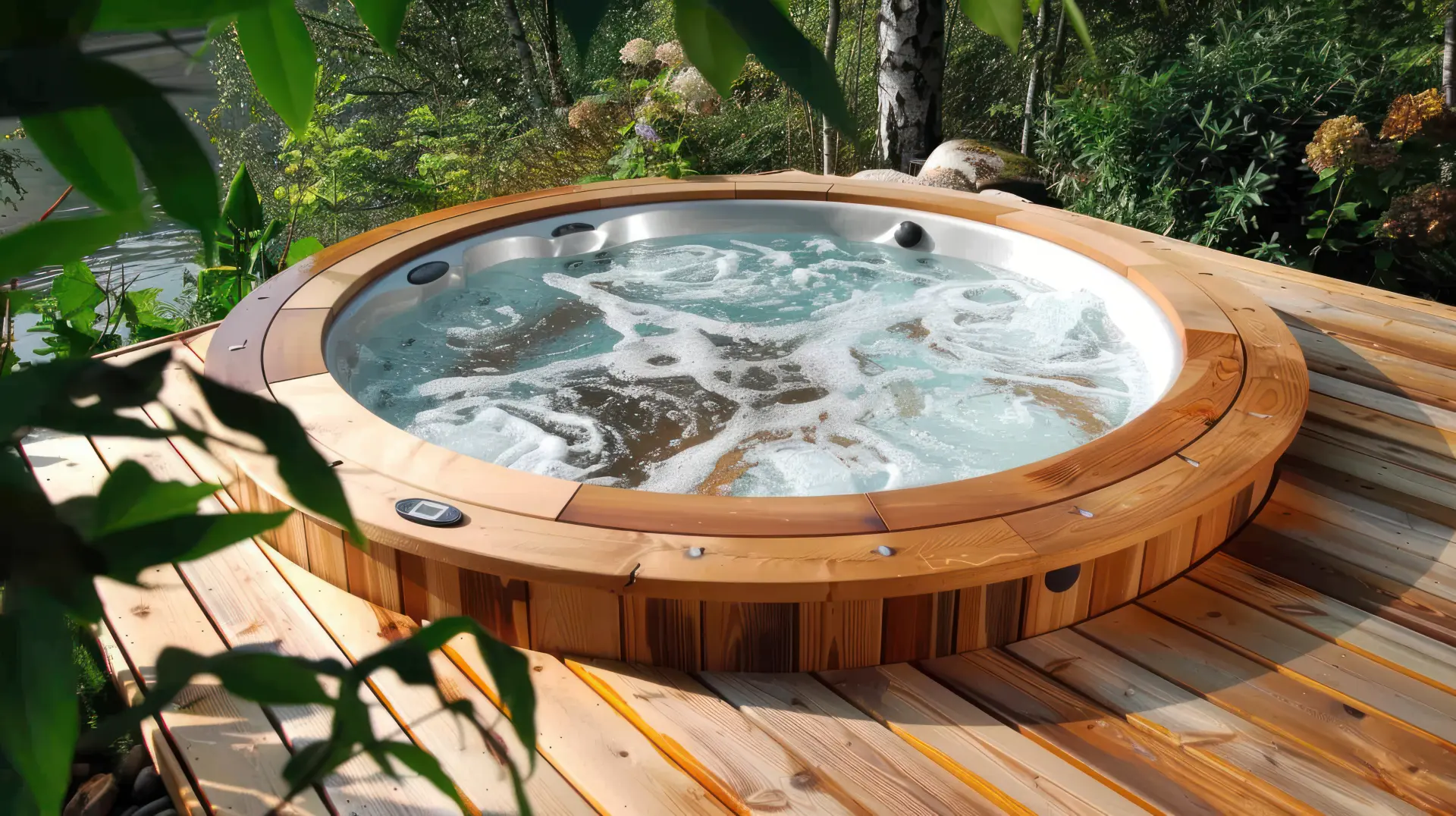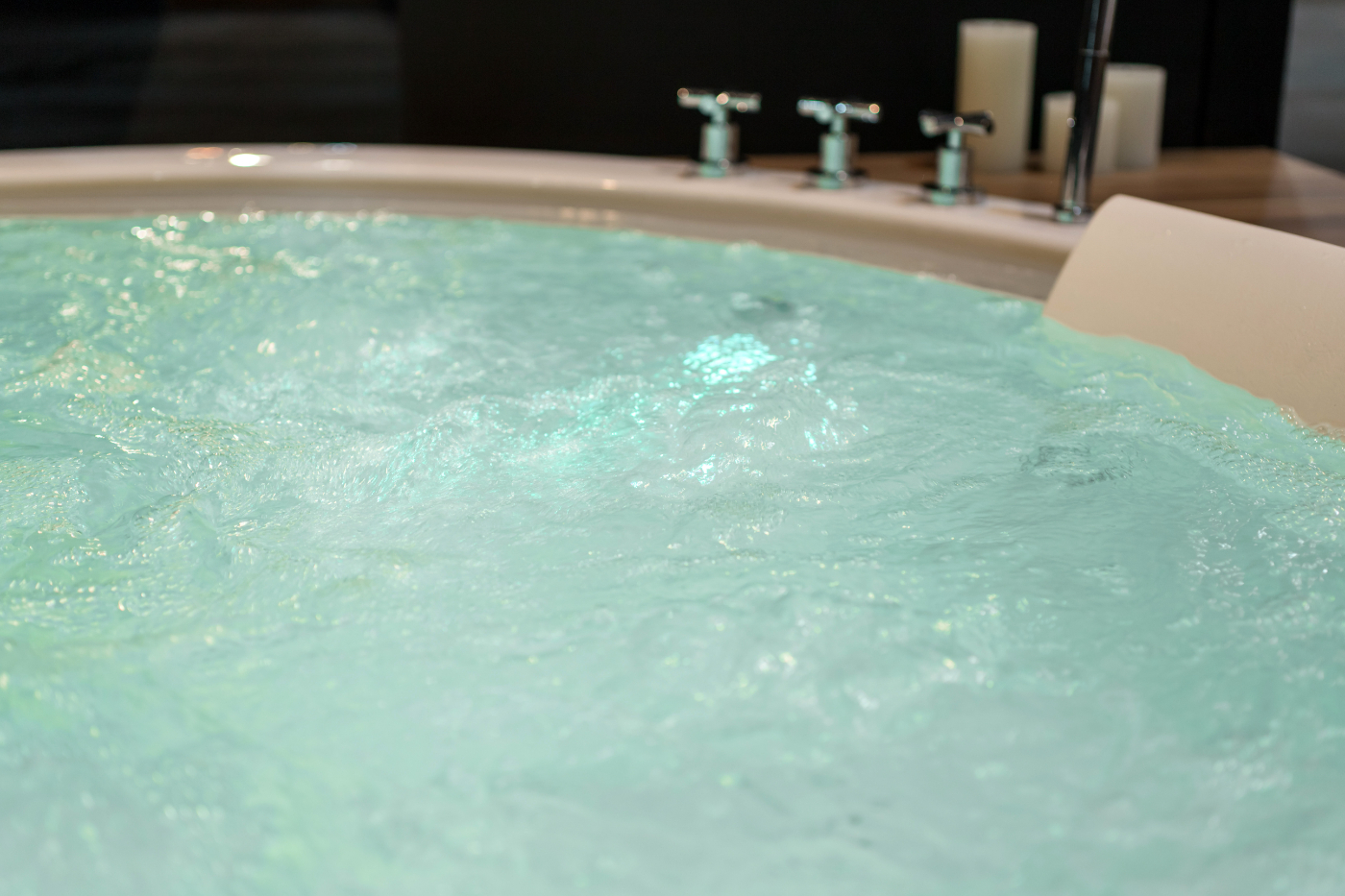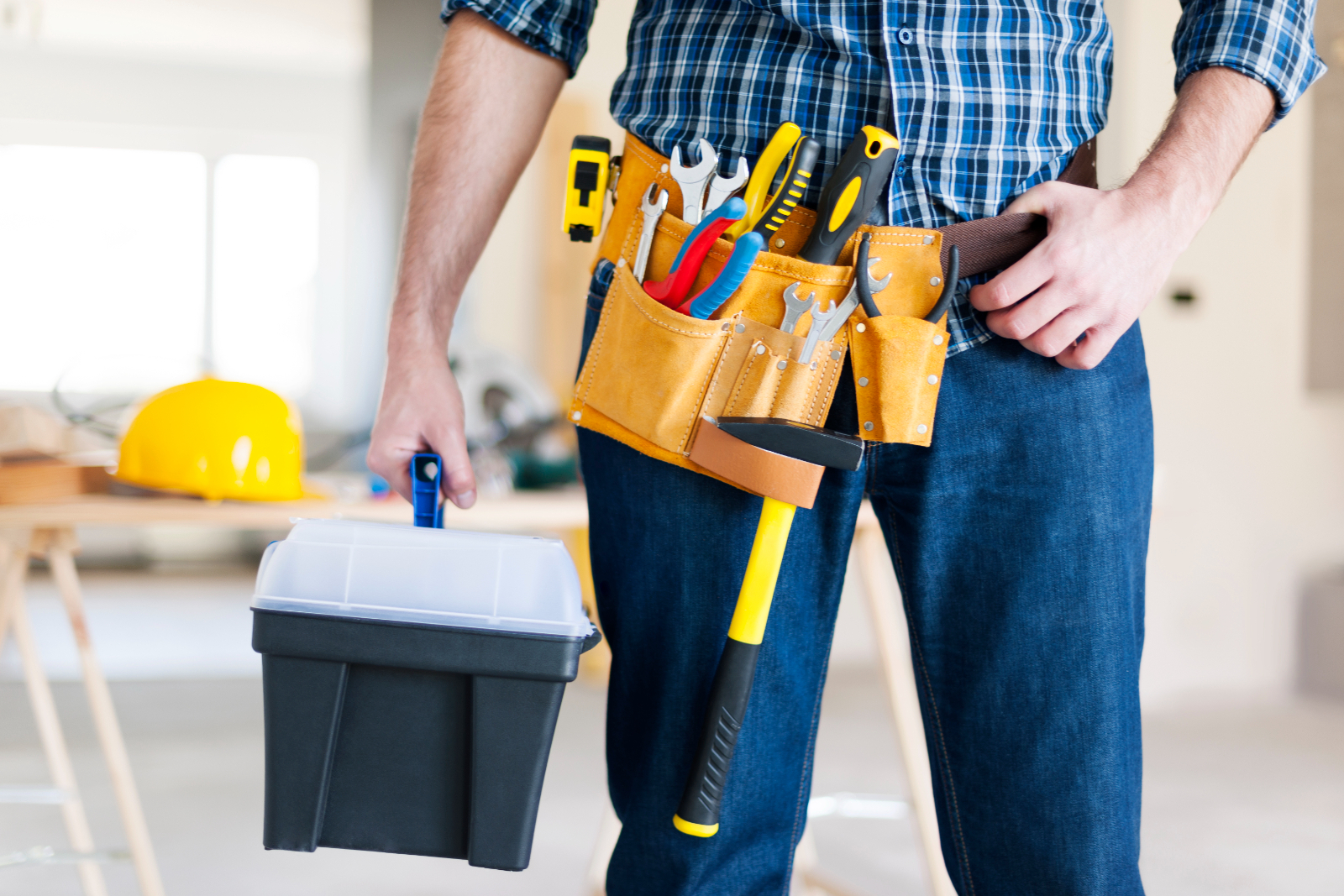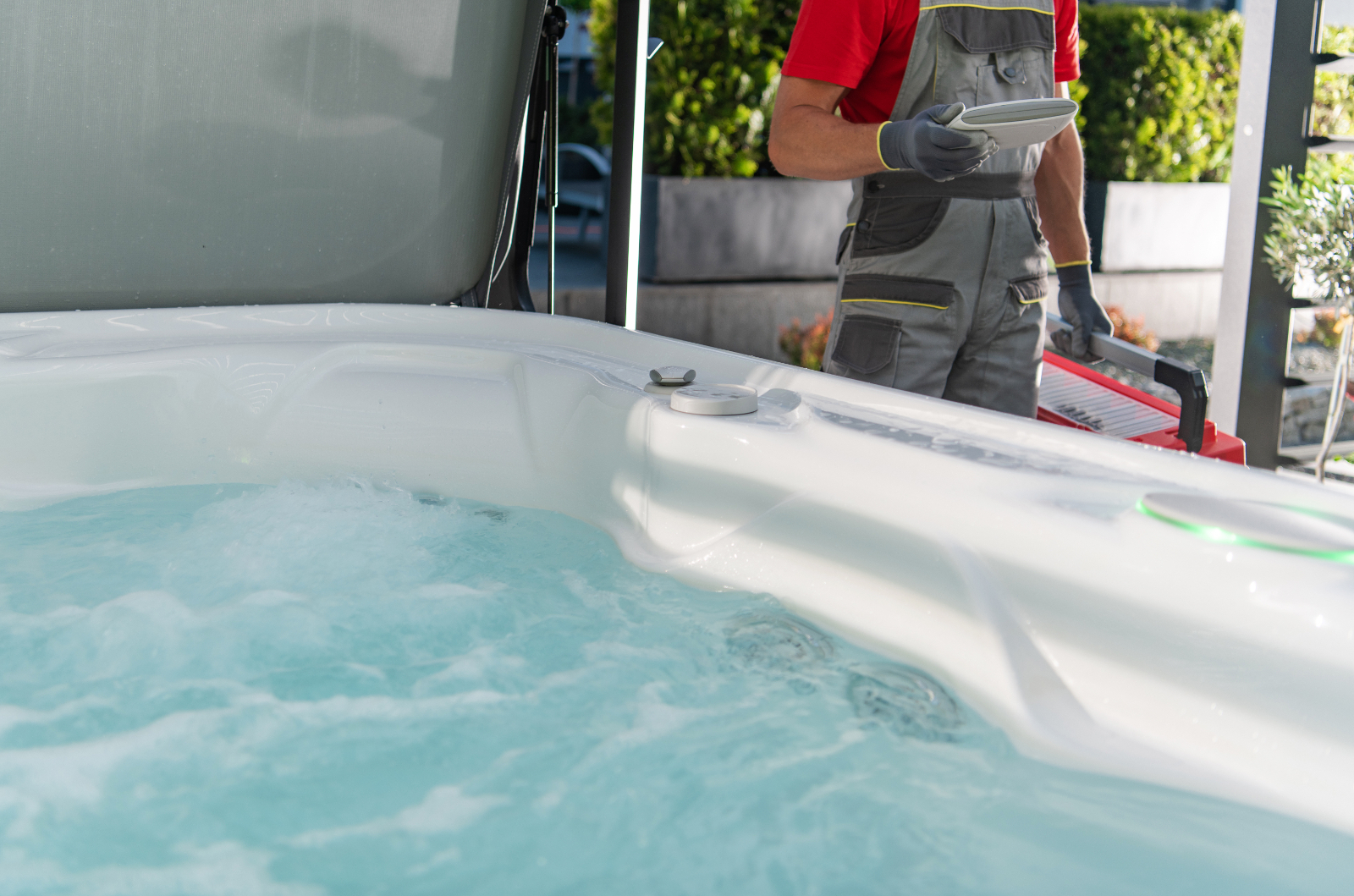Read our hot tub maintenance tips for keeping your tub in top shape. The Hot Tub Engineer provide hot tub maintenance across Maidstone and Kent. We ask: is a hot tub high maintenance, and what types of care are required for a hot tub. Our aim is to keep your hot tub water clean, safe and ready, so you can enjoy a relaxing soak at home.
Hot Tub Maintenance
Take time to become familiar with a few key phrases before you sink into the warm water of your new hot tub. Some people call it a hot tub, others say portable spa. It helps to know your model, age and water capacity. This makes it easy to find parts, follow the manual, and book a professional service when needed.
Hot tub maintenance is easy when you keep a routine. A simple maintenance schedule and a basic grasp of water chemistry are essential. You will use a few hot tub chemicals and test strips, which often cost about £20 per month. The main steps are circulation, cleaning and balancing. These steps help keep your spa water clear, reduce bacteria and contaminants, and maintain the system in good working order.

Good Hot Tub Circulation
You can keep the water clean by circulating it through the hot tub filter and any cartridge filters. Most hot tubs have an automatic cycle. They run once or twice a day to circulate water through the filters for 15 to 20 minutes. If your model does not do this, run the pumps twice a day for the same time. This helps the sanitiser circulate and can help keep chloramines low.
Use your hot tub often and keep the water moving. Oils from skin, lotions and soaps can collect in the water. A clean tennis ball can help absorb these organic compounds. This small step can help keep the water clean between deeper cleaning sessions.
Hot Tub Cleaning Schedule
Cleaning is a key part of hot tub care. If your tub sits outside, check for leaves, dirt and other debris after windy conditions or rain. Wipe the waterline and seats to remove any build-up. A little white vinegar on a soft cloth can remove the scum line and help keep the shell and jets free from grime.
Rinse and clean the hot tub cover each week to reduce mould and mildew. A 10 percent bleach-to-water mix can help. Make sure you rinse well after you clean. Every three to four months, plan a deep clean. Turn off the power, drain the spa with a garden hose, wipe all surfaces, and rinse. When you refill with fresh water, set a timer and check the level. This avoids overflows and protects the cabinet and components from damage.
Hot Tub Water Chemistry
Hot tub water needs the right balance to kill bacteria and help keep the water clean. Use hot tub chemicals designed for hot tubs, not swimming pools. Pool products can be too strong or the wrong type for hot spa water. You can use chlorine or bromine as your main sanitiser. Both are effective when used correctly. Chlorine tablets, chlorine granules and bromine tablets are common choices. Some people prefer non chlorine shock treatments as part of weekly water care.
Check chemical levels with test strips every week, or more often if many people use the tub. Keep pH levels and alkalinity in the ideal range. If the pH level is too low, the water is acidic and can cause corrosion and sore eyes. If it is too high, the water is alkaline and may cause scale, cloudy water and poor sanitiser action. Adjust as needed. Balance means longer life for parts, better heat transfer, and a more comfortable soak.
Choosing Safe Products
High quality products can be more effective and can reduce wear on your hot tub’s shell, jets and seals. Cheaper products may include fillers that leave residue, foam and scale. This can be a sign of poor water care. You may also notice strong smells, which can mean high chloramines. Always read the label and follow directions. Make sure the products you choose are meant for hot tubs. Using the right type helps protect components and keeps your hot tub clean.

The Effects of Cheap Chemicals on Hot Tub Surfaces
Low grade chemicals can upset pH and alkalinity. Over time you may notice a white ring at the waterline, scale on fittings, or signs of wear on vinyl and plastic parts. This can shorten the lifespan of filters, seals and heaters. If you notice damage, stop, test the water, adjust the balance, and consider a professional service for a system check.
Filter Care, Cleaning and Replacing
Hot tub filters do hard work. Remove the hot tub filters every week and give them a quick rinse to remove debris and dirt. Once a month, soak them in a filter cleaner following the label. Rinse well after soaking. Replace filters every year, or sooner if the pleats look worn or damaged. A clean hot tub filter helps water circulate well and keeps chemical use lower.
Shock Treatment and Weekly Care
A shock treatment helps oxidise oils and lotions. It also helps reduce cloudy water and smells. You can use either a chlorine shock or a non chlorine shock. Add shock every week, and after a big soak or a party. Make sure the cover is open when you shock the water. This helps gases escape and keeps the cover in good condition.

Draining, Refilling and Hard Water
Plan a full draining and refill every three to four months. If many people use the spa, or if the water starts to look dull, drain sooner. Hard water can cause scale on heaters and jets. If you live in a hard water area, consider a pre-filter on your hose when you refill. This can reduce minerals and help keep your hot tub in top condition.
Start Up, Shut Down and Seasonal Steps
When you start the hot tub for the first time, fill with fresh water, bleed air from pumps if required, and check for leaks. Heat the spa to your preferred soak temperature. Then add sanitiser and balance pH and alkalinity. In winter, keep the cover on when not in use. This holds heat in, reduces energy use, and protects the shell from low temperatures. If you plan to shut down for months, drain fully, remove water from the lines as the manual advises, and leave the cover on to keep out leaves and debris.
Cover Care and Heat Retention
A good hot tub cover is essential. Check hinges and straps for signs of wear. Keep the cover clean to reduce dirt and oils that can break down the vinyl. A well sealed cover helps maintain heat, lowers costs and helps keep chemical levels steady. Make sure it fits well to help keep children and pets safe.
People, Skin and Comfort
Balanced water protects skin and eyes, and helps prevent redness or itching. If your skin is sensitive, aim for a lower sanitiser level within the safe range, keep the pH and alkalinity on target, and rinse off after each soak. Keep hair products and fake tan out of the water. These can add contaminants and cause foam.
Troubleshooting Quick Wins
If water turns cloudy, test the pH and alkalinity, clean the filters, and add a shock treatment. If you see foam, reduce oils by rinsing swimsuits well and using shock. If algae appears, raise the sanitiser, shock, brush the shell and run the system to circulate the water. If you notice low flow, check for air in the lines, clean the filters, and make sure the water level is high enough.

CARE TIPS WHILE YOU’RE ON VACATION
Check the weather for the week you will be away. In warm conditions, algae can grow faster. Before you leave, test the water, balance pH and alkalinity, and add a shock treatment. Set your maintenance routine to a lower heat if the manual allows. Close and lock the hot tub cover. Turn off power at the breaker if the manual says this is safe for your model. When you get home, test again, adjust chemical levels, and enjoy a clean soak.
When to Replace and When to Call for Help
Some parts wear out over time. Replace filters each year. Replace perished seals or cracked jets when you see signs of wear. If you notice repeated tripping, error codes, leaks, or damage to electrical components, stop using the spa and call for a professional service. This protects your home and helps ensure safe use.
Simple Steps That Help Keep Your Hot Tub Ready
Make sure you test water every week. Adjust pH and alkalinity as needed. Rinse filters, keep the cover clean, and remove debris from the water with a hand skimmer. Follow the manual for your model. These steps help maintain your hot tub, extend the lifespan of parts, and keep your family safe.
At The Hot Tub Engineer, I provide expert-level services for hot tubs, swim spas, and pools in and around Maidstone, Kent. I can carry out yearly servicing appointments, as well as cleaning sessions, general maintenance, installations, and more.






